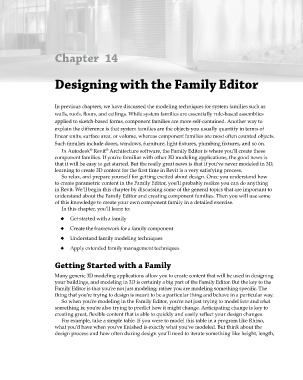Page 607 - Divyank Tyagi
P. 607
Chapter 14
Designing with the Family Editor
In previous chapters, we have discussed the modeling techniques for system families such as
walls, roofs, floors, and ceilings. While system families are essentially rule-based assemblies
applied to sketch-based forms, component families are more self-contained. Another way to
explain the difference is that system families are the objects you usually quantify in terms of
linear units, surface area, or volume, whereas component families are most often counted objects.
Such families include doors, windows, furniture, light fixtures, plumbing fixtures, and so on.
®
In Autodesk Revit Architecture software, the Family Editor is where you’ll create these
®
component families. If you’re familiar with other 3D modeling applications, the good news is
that it will be easy to get started. But the really great news is that if you’ve never modeled in 3D,
learning to create 3D content for the first time in Revit is a very satisfying process.
So relax, and prepare yourself for getting excited about design. Once you understand how
to create parametric content in the Family Editor, you’ll probably realize you can do anything
in Revit. We’ll begin this chapter by discussing some of the general topics that are important to
understand about the Family Editor and creating component families. Then you will use some
of this knowledge to create your own component family in a detailed exercise.
In this chapter, you’ll learn to:
◆ ◆ Get started with a family
◆ ◆ Create the framework for a family component
◆ ◆ Understand family modeling techniques
◆ ◆ Apply extended family management techniques
Getting Started with a Family
Many generic 3D modeling applications allow you to create content that will be used in designing
your buildings, and modeling in 3D is certainly a big part of the Family Editor. But the key to the
Family Editor is that you’re not just modeling; rather you are modeling something specific. The
thing that you’re trying to design is meant to be a particular thing and behave in a particular way.
So when you’re modeling in the Family Editor, you’re not just trying to model how and what
something is; you’re also trying to predict how it might change. Anticipating change is key to
creating great, flexible content that is able to quickly and easily reflect your design changes.
For example, take a simple table. If you were to model this table in a program like Rhino,
what you’d have when you’ve finished is exactly what you’ve modeled. But think about the
design process and how often during design you’ll need to iterate something like height, length,
c14.indd 573 5/3/2014 11:29:06 AM

